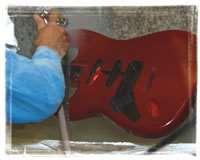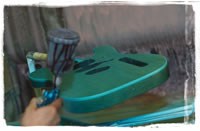Guitar Finishes that Strike a Chord with Buyers
Fender, the world-famous maker of fine electric and acoustic guitars, uses special coatings to enhance the look and feel of guitars...
From the heart-thumping vibes at a rock concert to the toe-tapping rhythms at a blue grass festival, the versatile guitar takes center stage in America’s most popular entertainment venues. For the musician, the feel of the fingerboard, the neck, body and ultimately the sound are crucial in selecting an instrument. But the look of the guitar, its color, styling and finish, are what create the initial allure and attraction to the instrument.
The makers of the world-famous line of guitars and amplifiers, Fender Musical Instrument Company (FMIC), know that it takes a lot more than great technology to attract buyers. Just like a car buyer may review statistics on gas mileage and safety features, experts say it’s the color, styling and look of the car that ultimately influence a buyer’s decision to purchase. The same holds true in the guitar business, says Richard McDonald, vice president of marketing for Fender at the company’s Scottsdale, Arizona location.
Featured Content
“Color and styling have a huge influence with our customers across the board,” he said. From the novice student picking out his first guitar to the professional musician, color holds the key.
To keep on top of what appeals to buyers, Mr. McDonald and his staff track trends in the auto and fashion industries. When the automotive industry introduced a palette of pale gold and bronze tones several years ago, Mr. McDonald was quick to apply this trend to his industry.
“We’re all influenced by the culture around us,” he said. “As artists, musicians are especially tuned in to what’s hot and up-and-coming.” Another more recent trend from the automotive industry is the use of silver. Mr. McDonald applied this trend to achieve the bright hues in chrome red and blue. Both colors are achieved using a silver base coat, which is more crisp and distinct than candy apple shades in red or blue, which have gold undertones.
Playing to the Audience
In addition to paying attention to the preferences of superstar musicians, McDonald is also mindful of what the younger, local talent wants from their guitars. “We noticed that kids were taking their brand new shiny guitars and intentionally marking them up with steel wool to make their instruments look worn,” Mr. McDonald said. “For this customer, shiny, new looking instruments are definitely not cool.”
As a response, FMIC set out to offer a guitar with a satin finish that would appeal to the younger musician. Offering this type of finish would also help bring the price down, since less workmanship is required in the final steps of painting and polishing. (Retail prices for Fender guitars can start as high as $1,200. The satin finished models are typically priced around $900.)
However, one of the problems often related to low-gloss finishes is the visible fingerprints left behind. Fender contacted several paint manufacturers about the issue and selected a coating from The Sherwin-Williams Company for the job. Sher-Wood® CAB-Acrylic Lacquer in a low-sheen satin offers just the right amount of luster to obscure fingerprints. It is also HAPS-compliant, resistant to moisture and yellowing and dries fast. Mr. McDonald selected dark velvety tones like burgundy, midnight blue and purple to appeal to the young audience.
For other color picks, Mr. McDonald took a cue from the popular three-tone sunburst pattern (featuring red and gold tones) introduced in the '50s, updating the look with silver and sapphire. Mr. McDonald also refers to colors like black, red and medium blue as “standards” that stay popular year after year.
Similar to automakers, Fender also plays to the niche markets by producing some guitar models in graffiti yellow and orange, or even a candy tangerine. “There’s always a small crowd that wants that off-the-wall color that makes you look twice,” said Mr. McDonald. “It’s a lot like the occasional bright yellow Ford Mustang you see cruising the highway.”
For Fender’s specialty line of vintage guitars called “Highway 1”, Sher-Wood CAB-acrylic lacquer in a high-gloss finish is used to capture the same look and feel of guitars manufactured in the 1940s and 1950s. “We have a large number of customers who are particularly nostalgic about this period in our line,” said Al Guzman, Fender senior vice president at the Corona, California manufacturing site.
To obtain their signature high-gloss, jewel-like finishes on models like the American Series “Stratocaster®,” Fender uses Polane® High-Solids Clear Topcoat. The coating is a two-component polyurethane coating that can also be used on metal and plastic. It is VOC and HAPS-compliant and resists moisture, chemicals, yellowing and damage from marring. For many of their colored finishes, the company adds specially formulated Sherwin-Williams Sher-Wood CAB-Acrylic Lacquer or Polane High Solids Clear. Topcoat. The tinted products are applied in three coats, followed by three clear coats. The colors used are carefully chosen and designed especially for Fender.
“ The quality of the colors we achieve is very important to us,” said Mr. Guzman. “We’re very particular about getting our colors and finishes as close to perfect as they can be,” he said. “There is a certain standard that customers can only get with a Fender product.”
Getting Down with the Details
Meeting customers’ high expectations begins with attention to detail and a manufacturing process that sets this guitar maker apart from the others. FMIC’s state-of-the-art manufacturing site in Corona, California encompasses more than 177,000 sq ft on 19 acres of land and is responsible for turning out the entire line of American-made guitars—approximately 350 guitars in as many as 65 different models a day.
The process begins in the woodshop section of the factory with a block of wood for the body of the guitar, typically ash or alder wood. Wood species such as hard rock maple or sugar maple are used for the neck because of their hard, stable properties. Wood sections are mechanically carved into the specified shape, followed by hand craftsmanship to add detail, smooth edges and clear away surface imperfections.
The second phase of manufacture is coating application to each separate piece of the guitar. This is the point at which a unique collaboration between Fender and Sherwin-Williams comes into play. When the new facility was originally built, company owners wanted to design a special paint room that would not only be conducive to efficient, consistently successful coating application, they also wanted the best system available for reducing and eliminating waste products.
Fender engineers worked with The Sherwin-Williams Company to determine the optimum conditions for coating application. At the new factory, sophisticated HVAC systems maintain a constant paint room temperature of 74F and an ability to control humidity.
“ Many things can affect the outcome of a coatings application,” said Gene Williams, a technical services specialist with The Sherwin-Williams Company. “That’s why it’s always critical to work in the best possible conditions.” Mr. Williams notes that optimum conditions including low humidity and a temperature around 70F are excellent for coating application.
Another measure to ensure successful application was also recommended. Since coatings are accessed through lines attached to containment wells, the lines are slightly warmed to improve flow. “By heating the lines, we’re able to control viscosity and consistency,” said Jeff Schuch, director of engineering for Fender. “Our painters know exactly what to expect when the coating comes out of the nozzle.”
An advanced air filtration system that combines ultraviolet light, a special scrubber process and a carbon bed absorption area, was also installed making the air emitted from the factory 95% clean of pollutants. The system works like this: coatings are sprayed on wood guitar parts that are mounted on tall wire bases. As the coatings are applied, a continuously flowing curtain of water (located about five feet from the active spray area) catches overspray into the stream. The water washes away airborne particles into a carbon bed absorption system.
“ The entire facility was designed with the environment in mind,” says Schuch. “We take extra care to reduce as much waste as possible.” The extra measures have also helped the company create the optimum conditions for coating applications. “In a controlled environment like our paint room, there’s no guesswork. Our painters can concentrate on the application process without worrying about mixing, or product consistency,” Mr. Schuch noted.
After guitar bodies and necks are carved and sanded, they are primed with a specialty polyester coating to seal the surface and provide a base coat. Multiple coats are applied until approximately 15 mils are achieved. Each layer of the primer coating is applied wet on wet. After curing, all parts are sanded by hand with 220-grit sandpaper in order to create a good mechanical bond. The next step is the application of either a lacquer or urethane coating.
Once the coating, hand sanding and polishing processes are completed, wooden guitar pieces are assembled and electric components and hardware are added. But the process of creating a true Fender isn’t complete until a professional musician tunes and tests each guitar. Although the company employs a staff of musicians for this purpose, many other employees from manufacturing to management are “retired” musicians.
At last count, the employees at FMIC corporate headquarters in Scottsdale moonlighted in at least eight rock and roll bands. “We’re a company made of people who really understand the musician and the instrument from the inside out,” said McDonald. It certainly shows.
RELATED CONTENT
-
A Current Affair: Examining the "No Amperage" Phenomenon
If you are performing a coating process that requires the use of a rectifier, you may have experienced the "no amperage" problem. Here's a look at the phenomenon and some solutions…
-
Painting Over Powder Coating
How safely can they apply their wet paint over our powder coated parts?
-
Preventing Solvent Pop
Preventing solvent pop on an industrial paint line...





















